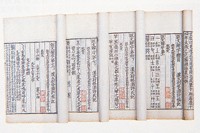1) Shuo Wen Jie Zi


《说文解字》
1.
A Philological Study of the Medicinal Herbs and Vegetables Represented by Characters under the Radical "艸" in Shuo Wen Jie Zi;
《说文解字》艸部药食类植物词语名称考释(之二下)——草药类
2.
Symmetrical Chinese Character of Xiao Zhuan in Shuo Wen Jie Zi;


试论《说文解字》小篆中的对称字
3.
Exploration of Ancient Jade Culture Reflected in Chinese Characters with the Radical of Jade in Shuo Wen Jie Zi (Annotations on the Chinese Characters);
《说文解字》玉部字显示的古代玉文化意识
2) Paraphrasing Texts and Words(Shuo Wen Jie Zi)


《说文解字》
1.
Chinese Culture Interpreted by “the heart ”Radical Chinese Characters in Paraphrasing Texts and Words(Shuo Wen Jie Zi);
《说文解字》“心”部字的文化阐释
2.
Chinese Culture Interpreted by Radical Chinese Characters of Roubu in Paraphrasing Texts and Words(Shuo Wen Jie Zi);
《说文解字》肉部的文化阐释
3.
Based on the Che radical Chinese characters collected in Paraphrasing Texts and Words(Shuo Wen Jie Zi),and according to the clue of the structure and meanings of the characters,this article seeks to explore the ancient Chinese Che-culture,from the origins,kinds and parts of Che,the actions concerning Che,the state,sound and imprint of Che and the driving force and usage of Che and so on.
以《说文解字》所收录的车部字为依据,以形义为线索,从车的起源,车的种类,车的部件,与车有关的动作,车状、车声、车迹,车的动力与车的用途等几方面,探索我国古代的车文化。
3) ShuoWenJieZi


《说文解字》
1.
This paper makes a comparison between Modern Chinese General Character List and ShuoWenJieZi, through the research of basically used characters\' volume, phonogram characters and high-frequency components that construct characters, proving that the system of Chinese characters has high stability.
本文将《现代汉语通用字表》和《说文解字》作为基础语言材料进行对比,从基本用字量、形声字、高频构字部件三个方面说明汉字系统具有较强的稳定性,又从现代汉字的构字法和构字理据以及反映新语素的新造字(化学用字、象声词用字、方言用字和借用字)两个方面论证了汉字系统在稳定之中有发展,并且汉字系统的稳定与发展是相辅相成的,其是在稳定的基础上进行发展的,同时发展的过程中又处处体现着稳态。
2.
The paper segregates the straight line to seek the original meaning,and points out the successful and fail analysis on straight line in Xu Shen’s shuowenjiezi,Duan Yu-cai’s shuowenjiezizhu and the original analysis on straight line in shuowenshili.
本文离析直线条探求本义,并指出许慎《说文解字》、段玉裁《说文解字注》有关直线条说解的得与失以及王筠《说文释例》有关直线条说解的独到之处。
3.
Shuowenjiezi is the first Chinese character book in China.


《说文解字》为我国字书之权舆,然历经改易,原本已不复存。
4) Explanation and Study of Principles of Composition of Character


《说文解字》
1.
Elaboration of Culture about Explanation and Study of Principles of Composition of Character;
《说文解字》宀部的文化阐释
2.
On the Chinese Residential Folk - custom Culture Implied in Explanation and Study of Principles of Composition of Character --A Sixth Research for the Being of Chinese Character Culture;
《说文解字》与居住民俗文化——《说文》汉字民俗文化溯源研究之六
3.
On the Chinese Dietetic Culture Connotated in Explanation and Study of Principles of Composition of Character ——A Third Research for the Beling of Chinese Character Culture;
《说文解字》蕴涵的中国饮食文化——《说文》汉字民俗文化溯源研究之三
5) Origin of Chinese Characters


《说文解字》
1.
A Research into Sun Rotation Recorded in Origin of Chinese Characters;


《说文解字》关于太阳循环记载的研究
6) shuowenjiezi


说文解字
1.
An Illustration on the Adopted Ideas of Shuowenjiezi from Weishu;


《说文解字》取资纬书说
2.
A Study of Agronomic Words in ShuoWenJieZi;


《说文解字》“禾、黍、来、麦”部的农业剖析
3.
The Study on Radicals Ba in Shuowenjiezi;


《说文解字》八部字研究
补充资料:《说文解字》
| 《说文解字》 中国最早的且对后代影响极大的一部字典。东汉许慎著。成书于和帝永元十二年(100),到安帝建光元年(121)。本书所收文字包括篆文(即小篆)、(古文壁中书)、籀文(大篆)、或体、俗体。“文”指的是整体象形表意字,“字”指的是结体有表形表声的合体字,所以许慎以“说文解字”为书名,后代常常简称为《说文》。全书以小篆为主体,分析字形结构,根据不同的偏旁,分立为514部,始于“一”部,终于“亥”部。凡字形偏旁或笔画接近的字都归于一部,举偏旁居一部之首。部与部排列的顺序《说文解字》书影(平津馆丛书本)大体以部首的笔画和形体结构是否相近为准则,笔画结构相近的就序列在一起。许书514部分为14篇,卷末叙目别为一篇,故为15篇。每部文字的排列主要本着3个原则:①文字在应用上的意思属于好的、善的列在前面属于贬义的、不好的列在后面;②一部之内属于专名词的列在前面,属于普通事物名词的列在后面;③一部之内的字,义类相近的序次在一起,以便寻检。每一篆文下先言义,后言形体结构,最后或说明读若某。小篆之外,如有籀文、古文异体,则列其下,名为“重文”。全书共收篆文9353字,重文1163字。古书中所使用的文字大体具备,其中既有先秦所有的字,也有汉代新产生的字,为后代考查汉字的发展历史提供了极其宝贵的材料。许慎分析字形,根据相传的“六书说”。象形、指事由字形以见义。会意、形声则分别其组合成分。凡言“从某从某”或言“从某某”都是会意字;凡言“从某某声”的都是形声字。书中也有会意兼形声的。也有言“从某某省声”的。许慎做了这些分析,对我们理解篆书的结构大有帮助,下而考察隶书也可以知道其来龙去脉,不知篆书形体,就难以明其音义。《说文》中的训释,或因形以说义,或取书传中的古训,灿然具备,虽为字书,实际也是一部极为重要的训诂书。后代的字书都援引《说文》训释,以为典要。
|
说明:补充资料仅用于学习参考,请勿用于其它任何用途。
参考词条
